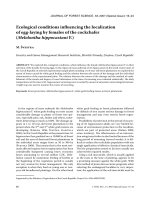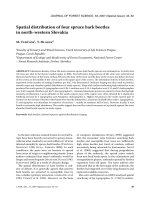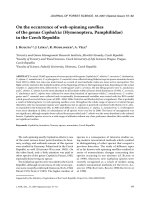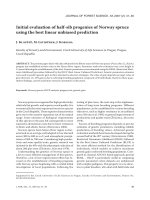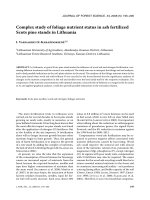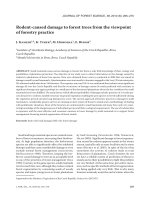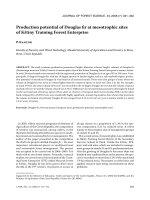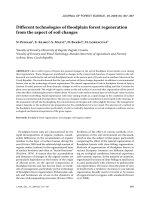Báo cáo lâm nghiệp: "Ecological requirements of some ant species of the genus Formica (Hymenoptera, Formicidae) in spruce forests" pps
Bạn đang xem bản rút gọn của tài liệu. Xem và tải ngay bản đầy đủ của tài liệu tại đây (389.03 KB, 9 trang )
32 J. FOR. SCI., 55, 2009 (1): 32–40
JOURNAL OF FOREST SCIENCE, 55, 2009 (1): 32–40
e ants of the genus Formica are a significant
component of forest ecosystems. They influence
soil qualities and the presence of some plant species
and they also have a strong influence on surround-
ing zoocoenosis (see V, H 2007). The
occurrence of ants is dependent on the quantity of
light (N et al. 1996; P et al. 1996;
S et al. 1999), the structure and quantity
of vegetation and the quantity of food supplies re-
lating to it (E, W 1982; S,
V 1989; G 1991; M 1998;
R, C 2000; M, C
2004; S, H 2005). Air and
soil temperatures are important for the activity of
workers (P, T 1987; S,
V 1989).
e presented paper deals with four universally
widespread Central European ant species of the
genus Formica: Formica fusca Linnaeus, 1758, For-
mica pratensis Retzius, 1783, Formica sanguinea
Supported by the Ministry of Agriculture of the Czech Republic, Project No. MZE 0002070201.
Ecological requirements of some ant species of the genus
Formica (Hymenoptera, Formicidae) in spruce forests
A. V
1,2
, J. H
1,3
, J. F
4
1
Forestry and Game Management Research Institute, Strnady, Frýdek-Místek Office,
Frýdek-Místek, Czech Republic
2
Department of Ecology and Environmental Sciences, Faculty of Science,
Palacký University in Olomouc, Olomouc, Czech Republic
3
Department of Forest Protection, Faculty of Forestry and Wood Sciences,
Czech University of Life Sciences in Prague, Prague, Czech Republic
4
Institute of Soil Biology, Biology Centre AS CR, České Budějovice, Czech Republic
ABSTRACT: Five types of stand stages (clearings-samplings, plantations, thinnings, thickets, and mature forests) of
spruce forests were examined at the foothills of the Jizerské hory Mts. in summer 2005 and 2006. e presence of ants
was surveyed by catching them into pitfall traps and observing on baits. Higher numbers of Formica fusca ants were
found in clearings-samplings and in plantations. eir activity was higher at the soil and air temperature of 20–30°C.
e peak of activity was observed in July. Most specimens were trapped at lighter habitats and in the sites with more
than 50% herbaceous and gramineous vegetation cover. F. pratensis was trapped in plantations and thickets. It was active
at the soil temperatures 12–21°C and air temperatures 16–25°C. It occurred both in dark and light areas. F. sanguinea
most commonly occurred in thinnings. is species was the most active at the soil temperature 20–30°C. Its activity
depending on air temperature grew almost linearly. It occurred both in dark and in light stand stages with at least 60%
vegetation cover. F. truncorum was observed only in thinnings. e activity of F. truncorum was the highest at the air and
soil temperatures 15–25°C. e peak of activity was recorded in July. It was observed only in stands with the quantity
of incident radiation 1,030 lx and with 20–80% of undergrowth cover.
Keywords: Formica; ecological requirements; spruce forests
J. FOR. SCI., 55, 2009 (1): 32–40 33
Latreille, 1798, and Formica truncorum Fabricius,
1804 (C et al. 2002).
e aim of the paper is to scientifically describe
the occurrence and activity of individual ant species
depending on stand age, intensity of light incident
upon the soil surface, quantity of undergrowth, and
air and soil temperatures in spruce forests.
METHODS
e studies were done in Norway spruce (Picea
abies [L.] Karst.) forests near Jablonec nad Nisou
(Czech Republic) at an altitude of 620–760 m. e
study area is in a slightly warm climatic zone with the
mean annual temperature and precipitation of 7°C
and 1,000 mm, respectively. As a result of this cli-
mate, podzols are dominant soil types. e original
beech woods were replaced by spruce monocultures
so that now the spruce is a predominant species in
this rugged upland (C 1996).
In 2005 and 2006 ant communities were sampled
in closed spruce forests in the age classes 0–2 (clear-
ings-samplings), 3–5 (plantations), 8–12 (thinnings),
26–41 (thickets) and 85–105 (mature forests) years
in five independent chronosequences (25 sites in
total). At each site, there were pitfall traps and baits.
Six traps were exposed at each site for 2 weeks in
June, July and August in both years.
e numbers of the particular species of ants were
surveyed by means of pitfall traps, which is the most
convenient method for these purposes (V et al.
submitted). e activity of workers depending on
air and soil temperature was observed by means of
baits. e baits were placed 30 cm from the pitfall
traps and were checked at the same times as the
pitfall traps but only twice each month. ey were
observed five times a day from 08.00 a.m. to 5.00 p.m.
Each bait contained 2 cm
3
of canned tuna fish meat
(including oil) and 1 cm
3
of honey, with both types
of bait-food placed at the opposite sides of a 15 cm-
diameter paper plate. e quantities of the baits were
precisely measured and supplied throughout the day.
e ants were identified using the taxonomic key of
C et al. (2002).
Air and soil temperatures were measured with a
Comet R0122 datalogger. An air temperature sensor
was located 20 cm above the soil surface; a sensor
measuring the soil temperature was placed circa
1 cm under the soil surface. e light incident upon
the soil surface was measured once a year during a
single cloudy day, which guaranteed the uniform
brightness of solar radiation. e quantity of the
incident light was measured at 10 different places
on each surface. e average quantity of the light
incident upon the soil surface was calculated from
the acquired data.
e undergrowth was characterized by the cover of
five 20% degrees. e acquired data were processed
in Microsoft Office Excel. e presence of species
in individual stand stages and the activity compare
among three months were compared by means of
one-way ANOVA and Tukey’s tests in Statistica 6.0
(StatSoft 2006). General linear models (quadratic
degree, Poisson distribution) were set up in Canoco
for Windows 4.0 ( B, Š 1998) to
delineate the dependence of individual species on
4.0
3.5
3.0
2.5
2.0
1.5
1.0
0.5
0.0
–0.5
–1.0
–1.5
Ants
1 2 3 4 5
Forest
0.12
0.10
0.08
0.06
0.04
0.02
0.00
–0.02
–0.04
–0.06
Ants
1 2 3 4 5
Forest
Fig. 2. Average number of F. pratensis (solid line) and F. trun-
corum (dash line) specimens trapped per one pitfall trap in
individual stand stages [1 … 0–2 years (clearings-samplings),
2 … 3–5 years (plantations), 3 … 8–12 years (thinnings),
4 … 26–41 years (thickets), 5 … 85–105 years (mature forests)]
Fig. 1. Average number of F. fusca (solid line) and F. sanguinea
(dash line) specimens trapped per one pitfall trap in individual
stand stages [1 … 0–2 years (clearings-samplings), 2 … 3–5 years
(plantations), 3 … 8–12 years (thinnings), 4 … 26–41 years
(thickets), 5 … 85–105 years (mature forests)]
34 J. FOR. SCI., 55, 2009 (1): 32–40
environmental factors. Scatter charts were created
in R 2.6.2. when the GLMs were not significant.
RESULTS
Only four species of the genus Formica were
recorded. F. fusca was trapped in the number of
383 specimens into pitfall traps and was observed
5,396 times on baits, F. sanguinea 849 specimens and
3,070×, F. trucnorum 8 specimens and 280 observa-
tions, F. pratensis 8 specimens and 28×.
F. fusca (F = 4.23, p = 0.042) was found to be more
numerous in clearings-samplings than in thickets
(p < 0.001), it occurred more often in plantations
than in thinnings (p = 0.01) and mature forests
(p = 0.04) (Fig. 1). F. fusca was the most active at the
air and soil temperature within the range of 20–30°C.
e temperatures lower than 10°C and higher than
40°C subdue its activity (Figs. 3 and 4). e activity
was significantly different among months (F = 10.48,
p < 0.001). It was higher in July and September than
in August (p < 0.001). Most specimens were trapped
at lighter habitats with the quantity of incident radia-
tion 3,000–8,000 lx (Fig. 5) and in the sites with more
than 50% herbaceous and gramineous vegetation
cover (Fig. 6).
Fig. 3. GLM of the activity of the F. fusca ants depending on
soil temperature (F = 66.43, p < 0.001)
Fig. 4. GLM of the activity of the F. fusca ants depending on
air temperature (F = 66.43, p < 0.001)
Fig. 5. GLM of the occurrence of the F. fusca ants depending
on the quantity of light incident upon the soil surface (F = 8.71,
p < 0.001)
Fig. 6. GLM of the occurrence of the F. fusca ants depending
on the quantity of undergrowth (F = 4.92, p = 0.008)
3.0
2.5
2.0
1.5
1.0
0.5
0.0
Response
Soil temperature (°C)
0 10 20 30 40 50
2.5
2.0
1.5
1.0
0.5
0.0
Response
Air temperature (°C)
0 10 20 30 40 50
2.0
1.5
1.0
0.5
0.0
Response
Light (lx)
0 2,000 4,000 6,000 8,000 10,000
Response
Undergrowth
0 1 2 3 4 5
2.0
1.5
1.0
0.5
0.0
J. FOR. SCI., 55, 2009 (1): 32–40 35
15
10
5
No. of ants
12 14 16 18 20
Soil temperature (°C)
15
10
5
No. of ants
16 18 20 22 24
Air temperature (°C)
Fig. 7. e activity of the F. pratensis ants depending on soil
temperature
Fig. 8. e activity of the F. pratensis ants depending on air
temperature
F. pratensis was trapped in plantations and in
thickets (Fig. 2) but due to the low number of exam-
ined specimens it was not possible to prove any sig-
nificant differences (F = 2.69, p = 0.303). F. pratensis
was observed to be active at the soil temperatures
13–21°C (Fig. 7) and air temperatures 16–25°C, the
air temperatures did not mostly exceed 21°C (Fig. 8).
e activity of workers did not differ among months
(F = 0.37, p = 0.69). It occurred both in dark and in
light areas (Fig. 9) independently of the undergrowth
density (Fig. 10).
F. sanguinea occurred differently in forest stages
(F = 6.11, p = 0.001); most commonly it occurred
in thinnings where it was significantly more nume-
rous than in thickets (p < 0.001) and mature forests
(p < 0.001) (Fig. 1). is species was the most active
at the soil temperature 20–30°C (Fig. 11); its activity
depending on air temperature grew almost linearly
(Fig. 12). e activity of workers did not depend on
the month of observation (F = 4.04, p = 0.18). It oc-
curred both in dark and in light stand stages, more
numerously by the radiation 1,800–6,000 lx (Fig. 13).
It is completely evident that it prefers stands with at
least 60% vegetation cover (Fig. 14).
F. truncorum was observed only in thinnings (Fig. 2)
but due to the low number of trapped specimens the
differences among individual types of stand stages
are not significant (F = 1.66, p = 0.156). e activity
Fig. 9. e activity of the F. pratensis ants depending on the
quantity of light incident upon the soil surface
Fig. 10. GLM of the occurrence of the F. pratensis ants depend-
ing on the quantity of undergrowth (F = 6.17, p = 0.002)
2.0
1.8
1.6
1.4
1.2
1.0
No. of ants
1,000 2,000 3,000 4,000
Light (lx)
10
8
6
4
2
0
–1
Response
Undergrowth
1 2 3 4 5
36 J. FOR. SCI., 55, 2009 (1): 32–40
of F. truncorum was the highest at the air and soil
temperatures 15–25°C (Fig. 15 and 16). e activity of
workers differed among months (F = 9.38, p < 0.001).
It was higher in July than in August (p = 0.001) and
September (p = 0.007). It was observed only in stands
with the quantity of incoming radiation 1,030 lx and
most often in stands with 40–60% of undergrowth
cover (Fig. 17).
DISCUSSION
All four species of ants inhabit a wider spectrum
of biotopes including conifer forests, and thus also
spruce forests. e occurrence of individual species
in different stand stages mostly corresponds with the
general requirements mentioned by other authors
(see below).
It is evident that the environmental factors meas-
ured by us depend on the age of a forest and on the
quantity of solar radiation penetrating into indi-
vidual stand stages.
F. fusca is a typical eurytopic and pioneering spe-
cies that inhabits various habitats (P et al.
1991; C et al. 2002). It occurs both in
dry and in wetland sites. It inhabits sunny habitats,
meadows, light and dense forests, wetlands, and
Fig. 11. GLM of the occurrence of the F. sanguinea ants de-
pending on soil temperature (F = 9.89, p < 0.001)
Fig. 12. GLM of the occurrence of the F. sanguinea ants de-
pending on air temperature (F = 33.02, p < 0.001)
120
100
80
60
40
20
0
No. of ants
2,0 00 4,000 6,000 8,000
Light (lx)
Fig. 13. e activity of the F. sanguinea ants depending on the
quantity of light incident upon the soil surface
Fig. 14. GLM of the occurrence of the F. sanguinea ants depend-
ing on the quantity of undergrowth (F = 4.06, p = 0.018)
3.0
2.5
2.0
1.5
1.0
0.5
0.0
Response
Undergrowth
1 2 3 4 5
Response
Soil temperature (°C)
0 10 20 30 40 50
1.4
1.2
1.0
0.8
0.6
0.4
0.2
0.0
Response
Air temperature (°C)
0 10 20 30 40 50
4
3
2
1
0
J. FOR. SCI., 55, 2009 (1): 32–40 37
rocks and artificial biotopes (V, Š 2001;
C et al. 2002; H, F 2005; G
et al. 2007). Yet it is evident that its numbers differ
depending on the type of biotope. In reclaimed areas
it was most often found in stands with autonomically
growing bushes and trees and least often in non-
reclaimed areas with initial successsional stages. It
was more abundant in open spaces than in forests
(H, F 2005). D and W (2004)
discovered differences not only among biotopes but
also differences depending on the location in a given
biotope.
F. fusca is a species common in spruce forests
(P et al. 1991; N et al. 1996). e
occurrence of this species in individual stands
(Fig. 1) entirely corresponds with information in
literature. In the Carpathian Mountains it was found
in the raspberry bush stage and one-year clear-cut
(M 1999). It is found particularly in young
stands including clearings, most numerously in
ten- up to twenty-years old stands (P et al.
1991; N et al. 1996). It can also occur in older
stands if they are photic enough, e.g. by means of
fragmentation or the presence of clearings (P-
et al. 1996).
N et al. (1996) believed that F. fusca do not
inhabit stands that are less than 10 years old and
more than 20 years old very much because colonies
of this species are dependent on direct solar ra-
diation and require open spaces and unclosed tree
layers. Similarly, during our research F. fusca was
found especially in lighter sites (Fig. 5). In the areas
with high density of the slaver species F. sanguinea,
F. fusca can be displaced into less convenient shady
localities (P et al. 1996).
F. pratensis is a polytopic species of dry habitats;
it lives in open sites in forests, treeless plains, mead-
ows and pasturelands (C et al. 2002).
It was also found on rocks or in artificial biotopes
(gardens, trenches; V, Š 2001); it was
rare in wet heathlands (M et al. 2003). In for-
ests it was found e.g. by H and F (2005)
but it was much more numerous on meadows in
the surrounding countryside. Its occurrence was
validated in oak forests and caussa, not in pine
forests (G et al. 2007). According to M
and K (2001) it prefers dry localities in
open stands.
Fig. 15. GLM of the occurrence of the F. truncorum ants de-
pending on soil temperature (F = 5.68, p = 0.003)
Fig. 16. GLM of the occurrence of the F. truncorum ants de-
pending on air temperature (F = 13.97, p < 0.001)
Fig. 17. GLM of the occurrence of the F. truncorum ants
depending on the quantity of undergrowth (F = 12.23,
p < 0.001)
40
30
20
10
0
Response
Undergrowth
1 2 3 4 5
0.15
0.10
0.05
0.00
Response
Soil temperature (°C)
0 10 20 30 40 50
0.20
0.15
0.10
0.05
0.00
Response
Air temperature (°C)
0 10 20 30 40 50
38 J. FOR. SCI., 55, 2009 (1): 32–40
It is very rare in spruce forests, it is found only
in young stands (up to 10 years) and on the edges
of older stands (P et al. 1991; N et
al. 1996). It was also found in older stands but very
rarely (Fig. 2).
Although we found out that its occurrence is inde-
pendent of the undergrowth cover (Fig. 10), M-
and K (2001) stated that F. pratensis
avoids dense undergrowth and high gramineous
vegetation, because it seeks food in trees and bushes
in particular. At extreme temperatures it decreases
its activity (H 2004). We also registered its
higher activity at temperatures lower than 24°C
(Fig. 8).
Although F. sanguinea is considered a forest spe-
cies inhabiting especially clearings and forest edges,
as a matter of fact it inhabits more of dry habitats
(C et al. 2002). It prefers sunny areas;
therefore it was found also on meadows, detritus,
quarries, rocks, displacements of stones on mead-
ows, and old dumping grounds (V, Š
2001; C et al. 2002) but also in anthro-
pogenic sites. In some areas it was found in open
areas and not in forests (G et al. 2007), in other
places more specimens were trapped in forests than
in open spaces (H, F 2005). In isolated
cases it is said to inhabit wet heathlands (M et
al. 2003).
In spruce forests it is one of the most numer-
ously represented species (P et al. 1991;
N et al. 1996). It is already found in clear-
ings (P et al. 1991, 1996; M 1999),
mostly, however, in young forests (2–0 years)
(P et al. 1991, 1996; N et al. 1996)
and also in mature forests (N et al. 1996).
Nonetheless, its occurrence in mature forests
probably depends on forest canopy because colo-
nies of this species are dependent on direct solar
radiation and require open spaces and unclosed
tree layers (N et al. 1996; P et al.
1996). Information in literature referring to the age
of forest and light demands corresponds with our
findings (Figs. 1, 13). F. sanguinea is able to form
very strong colonies only until the canopy closes
(P, H 1996). Another factor that
makes this species dominate in young forests is
interspecific relationships. The strongly aggressive
F. sanguinea displaces territorial wood ants into
older forests (P et al. 1996).
F. truncorum is bound especially to conifer and
mixed forests but it occurs also in deciduous forests.
It inhabits sunny places particularly in mid-forest
glades, open places and open stands (B 1960;
C et al. 2002). Even though it principally
lives in forest biotopes, in isolated cases it occurs on
shrubby meadows and rocks. It builds its nests of veg-
etable material leaned against tree stumps, more rarely
in tree stumps and independent hills (V, Š
2001); there were many nests on the south edges of
trunks of fallen trees (B 1960).
It is already found in clearings and young forests
(P et al. 1991, 1996; N et al. 1996)
only until the canopy is closed (P et al.
1996; M, K 2001). We vali-
dated its presence only in young forests (thinnings,
Fig. 2). It was not found in clearings, which could
have been caused by its low numbers in observed
localities.
We found out that F. truncorum mostly occurred
in areas approximately half covered with vegetation
(Fig. 17), which roughly corresponds to the thesis
that the F. truncorum ants avoid dense undergrowth
and high gramineous vegetation because they seek
food particularly in trees and bushes (M,
K 2001). On that account vegetation ef-
fects are indirect because they lie mainly in changes
in accessibility of food (P et al. 1991;
N et al. 1996; P, V
1996; P, H 1996; D, W
2005).
e activity of ants strongly depends on microcli-
mate conditions. e ant activity is affected mainly
by the temperature of soil surface (present study,
S 1980; M, M 1989; C
2005; A et al. 2007), but it may also be influ-
enced by wind (P 1935). e activity increases
with raising temperature (H 1955), reaches the
maximum and decreases later (present study, P,
C 2004; D et al. 2007; Z et al.
2007; A et al. 2007). e dependence of ac-
tivity on solar radiation has a very similar curve like
the dependence on soil or air temperature because
there is a significant correlation between the amount
of light and temperature (L et al. 2004).
But these relationships can be partly influenced by
photoperiod (N 1993) and of course by inter-
species competition (F 1989). We suggest that
microclimate conditions could explain differences in
the activities of F. fusca and F. pratensis during the
season. Another possible explanation of this differ-
ence is an oscillation of worker numbers during the
season (A 1929) as a result of available food
(D, S 1995).
Acknowledgements
We would like to express our thanks to Mgr. E
S for her help with the field works.
J. FOR. SCI., 55, 2009 (1): 32–40 39
R e fe re n ce s
ANDREWS E.A., 1929
. Populations of ant mounds. e
Quarterly Review of Biology, 4: 248–257.
AZCARÁTE F.M., KOVACS E., PECOL B.,
2007. Microcli-
matic conditions regulate surface activity in harvester ants
Messor barbarus. Journal of Insect Behavior, 20: 315–329.
BETREM J.G.,
1960. Formica truncorum F. niet inheems.
Entomologische Berichten (Amsterdam), 20: 130–134.
CULEK M.
ed., 1996. Biogeografické členění České repub-
liky. Praha, Enigma: 278.
CZECHOWSKI W., RADCHENKO A., CZECHOWSKA
W., 2002. e ants (Hymenoptera, Formicidae) of Poland.
Warszaw, Museum and Institute of Zoology PAS: 200.
DAUBER J., WOLTERS V
., 2004. Edge effects on ant com-
munity structure and species richness in an agricultural
landscape. Biodiversity and Conservation, 13: 901–915.
DAUBER J., WOLTERS V
., 2005. Colonization of temperate
grassland by ants. Basic and Applied Ecology, 6: 83–91.
DESLIPPE R.J., SAVOLAINEN R
., 1995. Mechanisms of com-
petition in a guild of formicine ants. Oikos, 72: 67–73.
DREES B.B.M., SUMMERLIN B., VINSON S.B., 2007. Forag-
ing activity and temperature relationship for the red im-
ported fire ant. Southwestern Entomologist, 32: 149–155.
ELMES G.W., WARDLAW J.C
., 1982. A population study of
the ants Myrmica sabuleti and Myrmica scabrinodis living
at two sites in the south of England. II. Effect of above-nest
vegetation. Journal of Animal Ecology, 51: 665–680.
FELLERS J.H.,
1989. Daily and seasonal activity in woodland
ants. Oecologia, 78: 69–76.
GALLÉ L.,
1991. Structure and succession of ant assemblages
in a north European sand dune area. Holarctic Ecology,
14: 31–37.
GROC S., DELABIE J.H.C., CÉRÉGHINO R., ORIVEL J.,
JALADEAU F., GRANGIER J., MARIANO C.S.F., DEJEAN
A., 2007. Ant species diversity in the “Grands Causses”
(Aveyron, France): In search of sampling methods adapted
to temperate climates. C.R. Biologies, 330: 913–922.
HARTNER A.,
2004. A Formica rufa L. és Formica pratensis
Retz. (Hym.: Formicidae) napi aktivitásának vizsgálata
belsö-somogyi mintaterületeken. Somogyi Múzeumok
Közleményei, 16: 337–341.
HOLEC M., FROUZ J.,
2005. Ant (Hymenoptera: Formicidae)
communities in reclaimed and unreclaimed brown coal
mining spoil dumps in the Czech Republic. Pedobiologia,
49: 345–357.
HOLT S.J.,
1955. On the foraging activity of the wood ant.
e Journal of Animal Ecology, 24: 1–34.
CHALLET M., JOST C., GRIMAH A., LUC J., THERAULAZ
G., 2005. How temperature influences displacements and
corpse aggregation behaviors in the ant Messor sancta.
Insectes Sociaux, 52: 309–315.
LAJZEROWICZ C.C., WALTERS M.B., KRASOWSKI M.,
MASSICOTTE H.B., 2004. Light and temperature differen-
tially colimit subalpine fir and Engelmann spruce seedling
growth in partial-cut subalpine forests. Canadian Journal
of Forest Research, 34: 249–260.
MABELIS A.A., KORCZYŃSKA J.
, 2001. Dispersal for
survival: Some observations on the trunk ant (Formica
truncorum Fabricius). Netherlands Journal of Zoology,
51: 299–321.
MACKAY W.P., MACKAY E.E.,
1989. Diurnal foraging
patterns of Pogonomyrmex harvester ants (Hymenoptera:
Formicidae). e Southwestern Naturalist, 34: 213–218.
MAES D., VAN DYCK H., VANREUSEL W., CORTENS
J., 2003. Ant communities (Hymenoptera: Formicidae)
of Flemish (north Belgium) wet heathlands, a declining
habitat in Europe. European Journal of Entomology, 100:
545–555.
MARKÓ B
., 1999. Ant community succession and diversity
changes in spruce forest clearcuts in Eastern Carpathi-
ans, Romania. In: TAJOVSKÝ K., PIŽL V. (eds), Soil
Zoology in Central Europe. České Budějovice, ISB AS
CR: 203–210.
MARKÓ B., CZECHOWSKI W.,
2004. Lasius psammophilus
Seifert and Formica cinerea Mayr (Hymenoptera: Formi-
cidae) on sand dunes: conflicts and coexistence. Annales
Zoologici (Warszawa), 54: 365–378.
MORRISON L.W.
, 1998. e spatiotemporal dynamics of
insular ant metapopulations. Ecology, 79: 1135–1146.
NIEMELÄ J., HAILA Y., PUNTTILA P.,
1996. e importance
of small-scale heterogeneity in boreal forests: variation in
diversity in forest-floor invertebrates across the succession
gradient. Ecography, 19: 352–368.
NORTH R.D., 1993. Entrainment of the circadian rhythm of
locomotor activity in wood ants by temperature. Animal
Behaviour, 45: 393–397.
PERFECTO I., VANDERMEER J., 1996. Microclimatic
changes and the indirect loss of ant diversity in a tropical
agroecosystem. Oecologia, 108: 577–582.
PICKLES W
., 1935. Populations, territory and interrelations
of the ants Formica fusca, Acanthomyops niger and Myrmica
scabrinodis at Garforth (Yorkshire). e Journal of Animal
Ecology, 4: 22–31.
POL R., DE CASENAVE J.L., 2004. Activity patterns of har-
vester ants Pogonomyrmex pronotalis and Pogonomyrmex
rastratus in the Central Monte Desert, Argentina. Journal
of Insect Behavior, 17: 647–661.
PORTER S.D., TSCHINKEL W.R.,
1987. Foraging in Solenop-
sis invicta (Hymenoptera: Formicedae): Effects of weather
and season. Environmental Entomology, 16: 802–808.
PUNTTILA P., HAILA Y., 1996. Colonisation of a burned
forest by ants in the southern Finnish Boreal Forest. Silva
Fennica, 30: 421–435.
PUNTTILA P., HAILA Y., PAJUNEN T., TUKIA
H.,
1991. Colonisation of clearcut forests by ants in the
southern Finnish taiga: a quantitative survey. Oikos,
61: 250–262.
40 J. FOR. SCI., 55, 2009 (1): 32–40
PUNTTILA P., HAILA Y., TUKIA H.,
1996. Ant communities
in taiga clearcuts: habitat effects and species interaction.
Ecography, 19: 16–28.
RETANA J., CERDÁ X
., 2000. Patterns or diversity and
composition of Mediterranean ground ant communities
tracking spatial and temporal variability in the thermal
environment. Oecologia, 123: 436–444.
SAVOLAINEN R., VEPSÄLÄINEN K
., 1989. Niche differ-
entiation of ant species within territories of the wood ant
Formica polyctena. Oikos, 56: 3–16.
SKINNER G.J
., 1980. Territory, trail structure and activity
patterns in the wood-ant, Formica rufa (Hymenoptera:
Formicidae) in limestone woodland in North-West England.
e Journal of Animal Ecology, 49: 381–394.
SORVARI J., HAKKARAINEN H.
, 2005. Deforestation
reduces nest mound size and decreases the production of
sexual offspring in the wood ant Formica aquilona. Annales
Zoologici Fennici, 42: 259–267.
SUOMINNE O., DANELL K., BERGSTRÖM
R., 1999. Moose,
trees, and ground-living invertebrates: indirect interactions
in Swedish pine forests. Oikos, 84: 215–226.
TER BRAAK C.J.F., ŠMILAUER P.,
1998. CANOCO Refer-
ence Manual and User’s Guide to Canoco for Windows:
Software for Canonical Community Ordination (version 4).
Microcomputer Power, Ithaca.
VÉLE A., HOLUŠA J
., 2007. Současné poznání biologie
a ekologie lesních mravenců (Hymenoptera: Formicidae).
Zprávy lesnického výzkumu, 52: 166–176.
VYSOKÝ V., ŠUTERA
V., 2001. Mravenci severozápadních
Čech. Ústí nad Labem, Albis Interantional: 211.
ZHENG J.H., MAO R.Q., ZHANG R.J., 2007. Comparisons
of foraging activities and competitive interactions between
the red imported fire ant (Hymenoptera: Formicidae) and
two native ants under high soil-surface temperatures. So-
ciobiology, 50: 1165–1175.
Received for publication June 12, 2008
Accepted after corrections September 23, 2008
Corresponding author:
Doc. ing. J H, Ph.D., Výzkumný ústav lesního hospodářství a myslivosti, v.v.i., Strnady,
pracoviště Frýdek-Místek, Nádražní 2811, 738 01 Frýdek-Místek, Česká republika
tel./fax: + 420 558 628 647, e-mail:
Ekologické nároky některých druhů mravenců rodu Formica
(Hymenoptera, Formicidae) ve smrkových lesích
ABSTRAKT: Výzkum probíhal v pěti typech porostních stadií (paseka, kultura, mlazina, tyčovina, dospělý porost)
smrkových lesů na úpatí Jizerských hor v létě roku 2005 a 2006. Přítomnost mravenců byla zjišťována pomocí odchytů
do zemních pastí a pozorováním na návnadách. Formica fusca byl nejpočetnější na pasekách a v kulturách. Jejich
aktivita byla nejvyšší při 20–30 °C teploty půdy i vzduchu. Sezonní aktivita kulminovala v červenci. Nejvíce jedinců
bylo odchyceno na slunnějších stanovištích a na místech s pokryvností vegetace více než 50 %.
F. pratensis byl odchy-
táván pouze v kulturách a tyčovinách a byl aktivní při půdní teplotě 12–21 °C a teplotě vzduchu 16–25 °C. Vyskytuje
se jak na tmavých, tak i na světlých stanovištích. F. sanguinea byl nejpočetnější v mlazinách. Byl nejaktivnější při
teplotách půdy 20–30 °C. Aktivita roste se zvyšující se teplotou vzduchu téměř lineárně. Vyskytoval se na tmavých
i světlých stanovištích s pokryvností vegetace vyšší než 60 %.
F. truncorum byl pozorován pouze v mlazinách. Akti-
vita F. truncorum byla nejvyšší při teplotě půdy i vzduchu 15–25 °C. Aktivita byla nejvyšší v červenci. Byl pozorován
v lesích, kam pronikalo záření 1 030 lx a měly pokryvnost 20–80 % vegetace.
Klíčová slova: Formica; ekologické nároky; smrkové lesy

